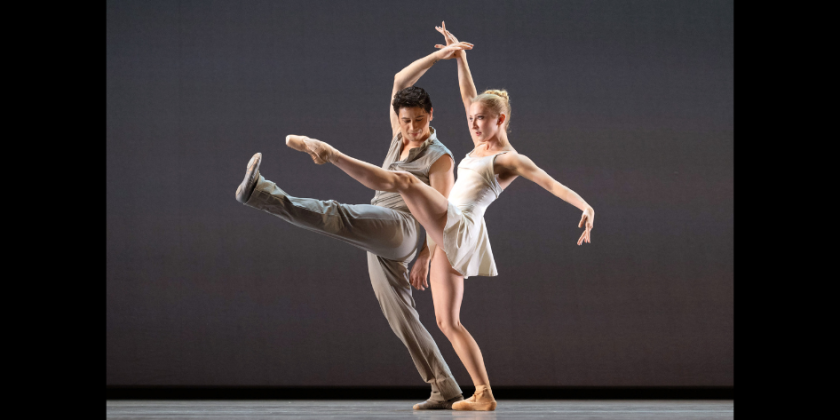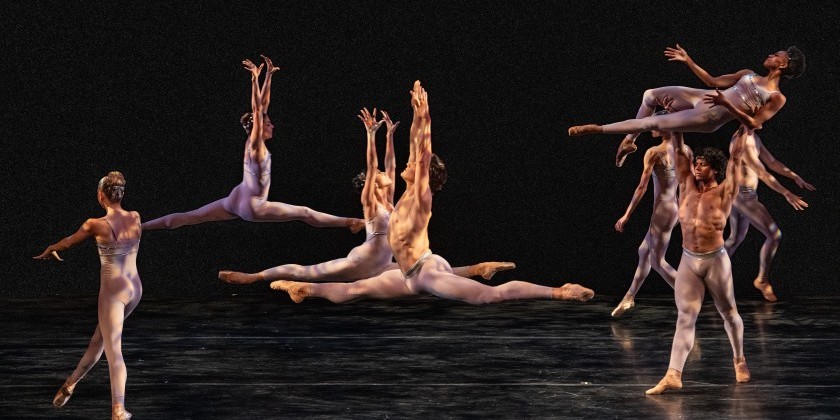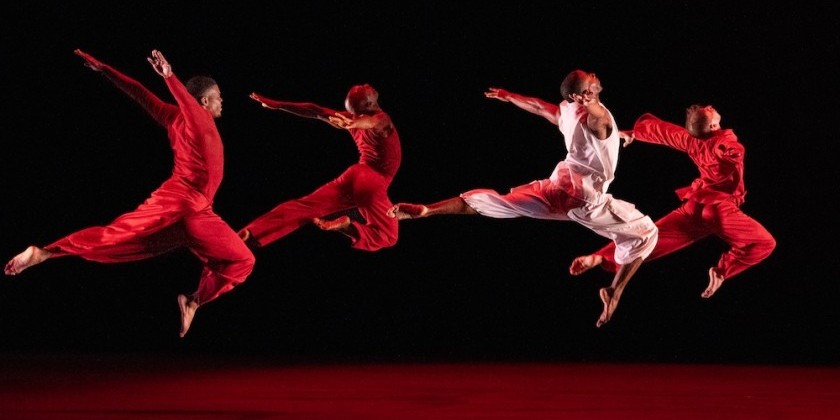IMPRESSIONS: New York City Ballet in "Innovators and Icons I" at Lincoln Center
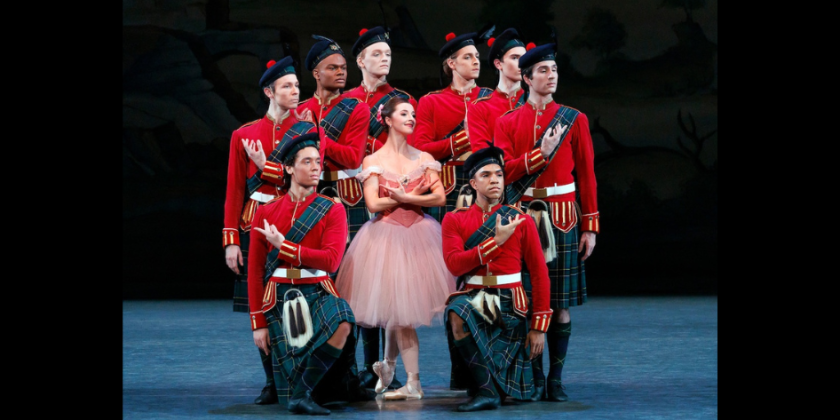
2025 Spring Season: April 22 – June 1, 2025
Guest Conductor: Emmanuel Plasson
April 24, 2025: Scotch Symphony starring Woodward, Bolden (replaces Furlan), Jones, Habony, Boisson, Abreu, Soares | Belles-Lettres starring Phelan, *Maxwell, Laracey, Pollack, *Chan, Bolden, *Mabie, Stanley, *Gabriel and piano solo by Gosling | Glass Pieces starring Afanasenkov, Mabie, Adams, *Klesa, Dutton-O’Hara, Soares, Phelan, **Furlan
April 30, 2025: Scotch Symphony starring E. Von Enck, Mabie, C. Von Enck (replaces Macgill), Habony, Boisson, Abreu, Soares | Belles-Lettres starring Nadon, M. Williams, Woodward, Hod, Chamblee, Knight, Furlan, Abreu, Takahashi, piano solo by Gosling | Glass Pieces starring Lister, Knight, Corrigan, Read, Lundgren, Flacke, Hod, Sanz
Pieces by two composers from the Romantic period and a composition by Philip Glass provide the framework for New York City Ballet’s Innovators and Icons I program.
Choreographer George Balanchine chose the 2nd, 3rd and 4th movements of Felix Mendelssohn’s Third Symphony in A Minor to create a ballet with a Scottish theme. Inspired by a walking tour of Scotland in 1829, the composer wrote to his family that he had found the beginning of his “Schottische.” After initial inspired work on it, however, he did not finish the composition until 1842, when it was first performed in Leipzig.
Emma Von Enck with Mckenzie Bernardino Soares and Victor Abreu in George Balanchine’s Scotch Symphony. Photo: Erin Baiano
After its premiere, Mendelssohn never referred to his Third Symphony as Scottish again, but the name stuck, and Balanchine picked up on it. For his ballet Scotch Symphony, he had designer Karinska clad his male dancers in kilts and the women in sylph-like romantic tutus. After New York City Ballet’s first tour to the Edinburgh Festival, in August of 1952, Balanchine created the work for his soon to be ex-wife, Maria Tallchief, and Andre Eglevsky. With Patricia Wilde in a solo part, the work premiered at City Center the same November.
While Scotch Symphony does have romantic elements, it never quite limits itself to one genre. As the female soloist, Baily Jones cavorts happily in a folksy manner with male demi-soloists Victor Abreu and McKenzie Bernardino Soares. It’s as if she is one of the boys, since she gets to wear a kilt, too.
Emma Von Enck and Jules Mabie in George Balanchine’s Scotch Symphony. Photo: Erin Baiano
The leading couple approach their romance with lightness; and when the group shields the ballerina in what seems to be a game of hide and seek, the action is intermittently comedic. No matter: Indiana Woodward and Gilbert Bolden III obviously enjoy dancing with one another, and their partnering looks at all times secure and polished, despite Bolden stepping in for another dancer. When male dancers lift Woodward overhead, before Bolden has to catch her, one does not have to worry. The other cast approaches the work with youthful enthusiasm. Emma von Enck and Jules Mabie as the principal couple make me root for them; and diminutive Claire von Enck in the soloist role next to elegant, long-legged Soares puts a smile on my face. The kids are alright.
Although I had seen (and reviewed) Justin Peck’s Belles-Lettres when it premiered during the 2014 Fall Fashion Gala, I was not quite prepared for the surprise one of the performances this season had in store for me. Designed for four couples and a single man, the ballet’s costumes (by Mary Katrantzou) feature appliqued letters made from lace on the men’s unitards. Apparently, it is not easy to wear the unitards because the letters do not stretch; and unfortunately, the fact that there are letters at all gets lost somewhere starting around Row M.
Taylor Stanley and Brittany Pollack in Justin Peck’s Belles-Lettres. Photo: Erin Baiano
The four couples appear in indistinguishable lush duets, until another male dancer joins a pairing. Shortly after, a woman comes in and shows jealousy. Then the proceedings turn comical for a moment, as the group continues to grow. The women’s dresses move beautifully, but the most dashing movements belong to soloist David Gabriel (who debuts in the role), and, in the other cast, to KJ Takahashi. How hard — both technically and aerobically — the male solo part truly is, I realize through Takahashi’s brilliantly executed performance, which makes me focus on the steps, and leaps, and all the fast footwork that Peck has built in. Somehow, Gabriel’s interpretive journey transports me beyond these details. Gabriel’s performance stirs me, and lets me see this work in a new light.
David Gabriel and the Company in Justin Peck’s Belles-Lettres. Photo: Erin Baiano
The ballet starts with Gabriel in the center of the four couples, and his attentiveness lets me know he cares about the people surrounding him. His performance opens my eyes. Could he be a writer and could the four heterosexual couples be his creations? His hand quivers, and his neck juts forward as if examining a page or an imagined character; and when he sees the dancing couples, he seems happy about his visions. I might conjure up all of it, but the freedom of his expressive hands, and the alertness and love that Gabriel brings to the role speak volumes about the possibility of imagination and fantasy. Gabriel observes the others, and seems to explode with improvised ideas. I am at the edge of my seat watching him. He does not perform; he lives within his (or my?) imagined environment. If only the ballet around him were as interesting as his performance. At least Peck does give everyone the chance to move, and makes the dancers look good. Pianist Stephen Gosling’s rendition of César Franck’s Solo de piano avec accompagnement de quintette à cordes, under the baton of guest conductor Emmanuel Plasson, winningly supports the choreography.
![]()
KJ Takahashi in Justin Peck’s Belles-Lettres. Photo: Erin Baiano
The evening’s closing number, Jerome Robbins’s Glass Pieces (to Rubric and Facades, both from Philip Glass’s Glassworks), juxtapose
Ashley Hod and Aarón Sanz in Jerome Robbins’ Glass Pieces. Photo: Erin Baiano
Ashley Hod and Aaron Sanz do have beautiful physiques, but Sanz at points looks as if he forgets to breathe; and his held energy makes him appear not quite rooted. Nevertheless, he displays gorgeous lines. Hod — with her fantastically long legs — never falters, and quietly slices the space to her (and my!) liking. The closing ensemble section, to excerpts of Glass’s opera Akhnaten, energizes the theater with men crossing the space in invigorating rhythms. A section for women comes sandwiched between the men’s explorative ritual and the grand finale for the whole group. It feels too dainty, as if Robbins in his postmodern creation relegates women to the status of second-class citizens when they are on their own. That he knows how to make both men and women shine when he has them dancing together, makes the finale an electric celebration.




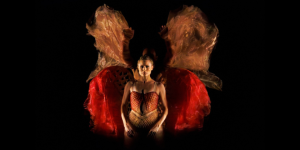
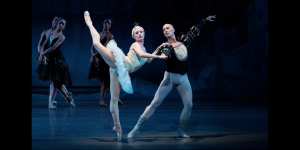

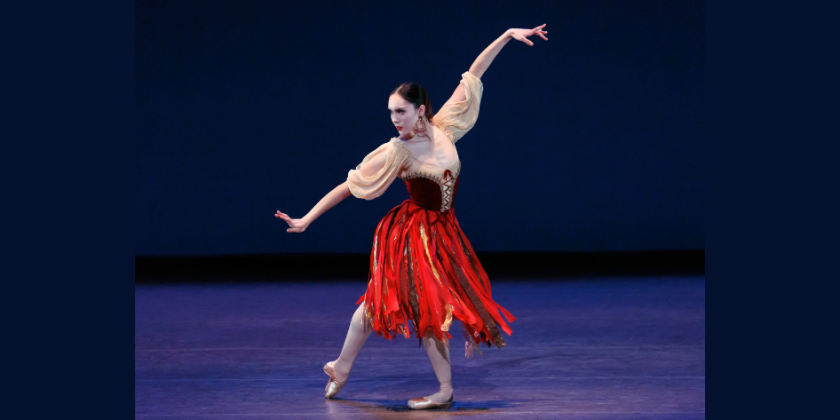
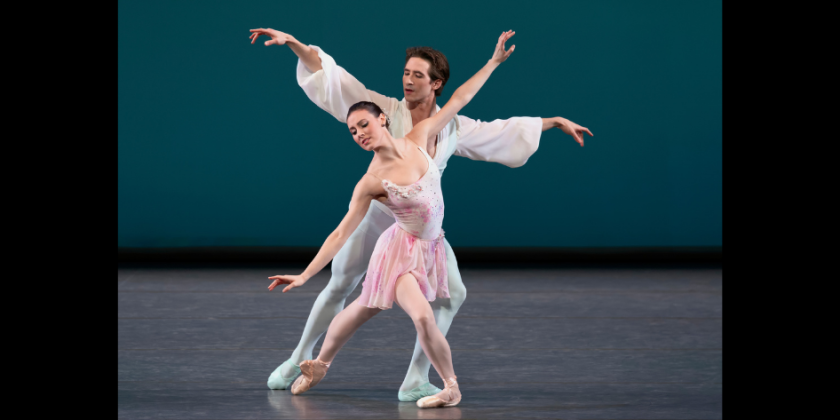
![IMPRESSIONS: Will Rawls' “[siccer]” at the Keith Haring Theatre at Performance Space New York](/images/features_large/20251119_WillRawls_siccer_PerformanceSpaceNY_WhitneyBrowne--55.jpg)
